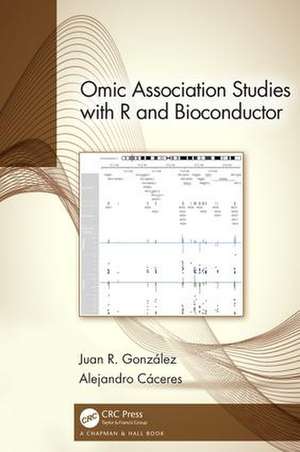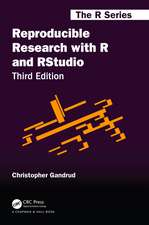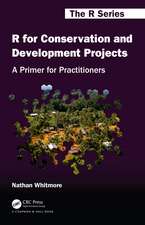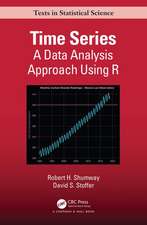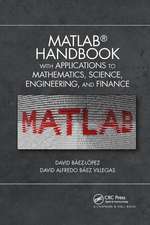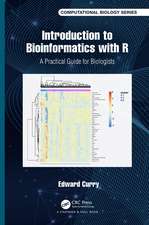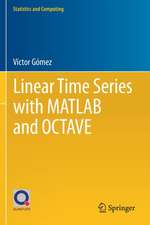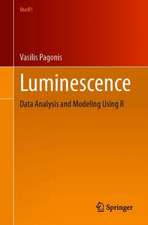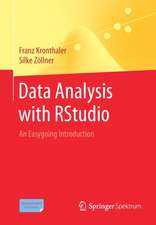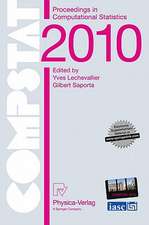Omic Association Studies with R and Bioconductor
Autor Juan R. González, Alejandro Cáceresen Limba Engleză Hardback – 11 iun 2019
- Emphasises extracting biologically meaningful associations between traits of interest and genomic, transcriptomic and epigenomic data
- Uses up-to-date methods to exploit omic data
- Presents methods through specific examples and computing sessions
- Supplemented by a website, including code, datasets, and solutions
| Toate formatele și edițiile | Preț | Express |
|---|---|---|
| Paperback (1) | 314.14 lei 6-8 săpt. | |
| CRC Press – 18 dec 2020 | 314.14 lei 6-8 săpt. | |
| Hardback (1) | 602.10 lei 6-8 săpt. | |
| CRC Press – 11 iun 2019 | 602.10 lei 6-8 săpt. |
Preț: 602.10 lei
Preț vechi: 804.21 lei
-25% Nou
Puncte Express: 903
Preț estimativ în valută:
115.23€ • 119.85$ • 95.13£
115.23€ • 119.85$ • 95.13£
Carte tipărită la comandă
Livrare economică 15-29 aprilie
Preluare comenzi: 021 569.72.76
Specificații
ISBN-13: 9781138340565
ISBN-10: 1138340561
Pagini: 390
Ilustrații: 100
Dimensiuni: 156 x 234 x 22 mm
Greutate: 0.73 kg
Ediția:1
Editura: CRC Press
Colecția Chapman and Hall/CRC
ISBN-10: 1138340561
Pagini: 390
Ilustrații: 100
Dimensiuni: 156 x 234 x 22 mm
Greutate: 0.73 kg
Ediția:1
Editura: CRC Press
Colecția Chapman and Hall/CRC
Cuprins
1 Introduction 2 Case examples 3 Dealing with omic data in Bioconductor 4 Genetic association studies 5 Genomic variant studies 6 Adressing batch effects 7 Transcriptomic studies 8 Epigenomic studies 9 Exposomic analysis 10 Enrichment analysis 11 Multiomic data analysis
Notă biografică
Juan R. González is an Associate Research Professor leading the Bioinformatics Research Group in Epidemiology at Barcelona Institute for Global Health. He has published extensively on methods and bioinformatics tools to detect structural variants from genomic data and to perform different types of omic association studies. Dr. González is the author of a large number of R and Bioconductor packages including state-of-the-art libraries such as SNPassoc or MAD that have been used to discover new susceptibility genetic factor for complex diseases.
Alejandro Caceres is a Senior Statistician in the Bioinformatics Research Group in Epidemiology at Barcelona Institute for Global Health. He has large experience in developing new statistical methods to exploit genomic, transcriptomic and epigenomic data obtained from public repositories. Dr. Cáceres is the author of several R and Bioconductor packages that have been used, for instance, to study the role of polymorphic genomic inversions in complex diseases or to investigate how the downregulation of chromosome Y may affect age-related diseases.
Alejandro Caceres is a Senior Statistician in the Bioinformatics Research Group in Epidemiology at Barcelona Institute for Global Health. He has large experience in developing new statistical methods to exploit genomic, transcriptomic and epigenomic data obtained from public repositories. Dr. Cáceres is the author of several R and Bioconductor packages that have been used, for instance, to study the role of polymorphic genomic inversions in complex diseases or to investigate how the downregulation of chromosome Y may affect age-related diseases.
Recenzii
"This book is a good tool for self-learning analytical strategies for omics data. It requires previous knowledge of R and focuses on getting things done...I think the book would be a good reference for masters or PhD students that have to perform their analysis and need a starting point. Also, for the practicing statistician working with omics data."
- Victor Moreno, ISCB News, July 2020
"Omic Association Studies with R and Bioconductor is an excellent tool book for those looking to have hands-on guidance to analyze multiomics datasets using established packages. The authors provide comprehensive examples of using genomic, transcriptomic, epigenomic, and exposomic data, as well as their integration, to generate biological hypotheses and explore individual heterogeneity."
– Biometrics
- Victor Moreno, ISCB News, July 2020
"Omic Association Studies with R and Bioconductor is an excellent tool book for those looking to have hands-on guidance to analyze multiomics datasets using established packages. The authors provide comprehensive examples of using genomic, transcriptomic, epigenomic, and exposomic data, as well as their integration, to generate biological hypotheses and explore individual heterogeneity."
– Biometrics
Descriere
This book presents current methods to perform informative analyses using real and illustrative data with established bioinformatics tools, and guides the reader through the use of publicly available data. The code and datasets, as well as solutions will be accessible online to help readers reproduce all results and figures in the book.
